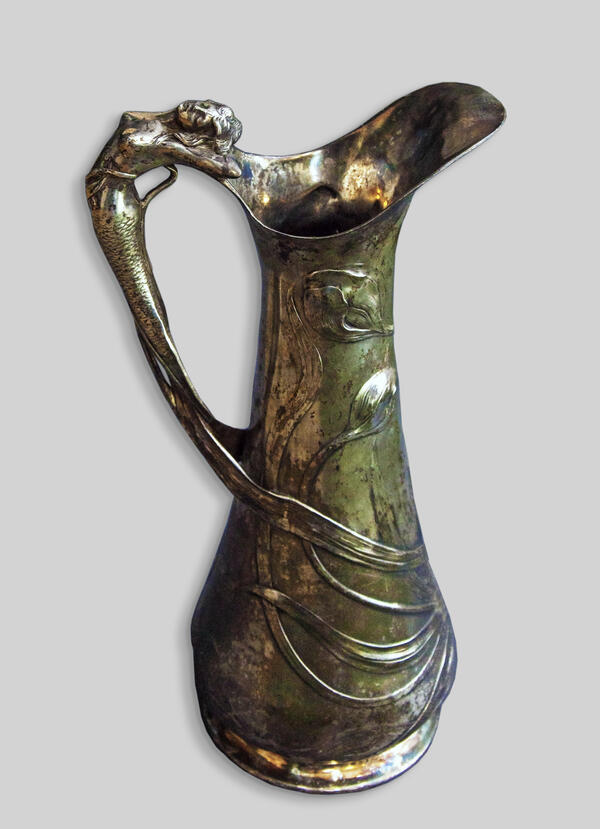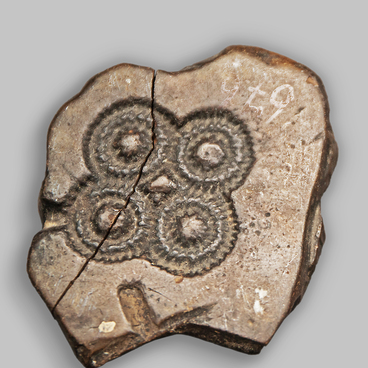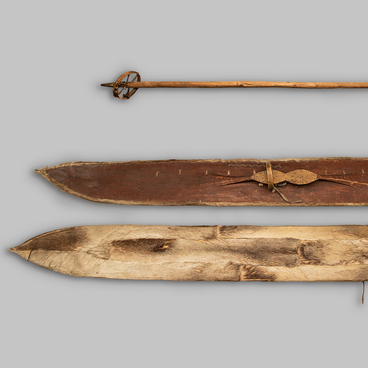A metal jug with a handle in the form of a mermaid was made in the 19th century. It was not immediately included in the collection of the Tobolsk Provincial Museum. In 1920, the jug was transferred from the State Museum Fund to the Tobolsk Museum of Fine Arts. The latter had just been opened at the Mariinskiy Girls’ School on the initiative of local artist Panteleymon Chukomin, and the museum was just beginning to collect exhibits. In addition to the jug, porcelain, paintings, and a collection of Kasli art iron casting were brought from the Museum Fund.
In the funds of the Tobolsk Provincial Museum, at that time the Museum of the Tobolsk North, the jug arrived when in 1925 the institution was transferred to the building of the Bishop’s House, which was located on the territory of the Tobolsk Kremlin. During this period, it was given collections from the Museum of Fine Arts, which by that time had stopped working.
The jug was created in the dishing technique being a method of metal working with hammers of different types and heaviness. It was also called a knockout or ‘broken copper’. Under the blows, the metal sheet was stretched, bent, fitted and gradually acquired the shape that the master needed. The dishing was different from the conventional forging given the fact that the metal remained cold, while during the forge works, the metal sheets were heated red-hot. The dishing can be performed only on thin metal sheets of no more than 2 mm in thickness. In contrast to coining where the masters worked on a metal sheet with special chisels and gad pickers, only hammers with regular or figured strikers are needed for the dishing.
The dishing artisans use in the course of their work more than 100 different hammers made of solid wood, such as beech, hornbeam, maple, and boxwood. The culture of artistic metalworking was formed in Russia in the 17th century. From the time of Peter the Great to the beginning of the 20th century, the Russian dishing art evolved and became more and more similar in style to Western European techniques. These include a jug from the Tobolsk Provincial Museum.
The master used a sheet of white alloy. He put an image of an iris flower on the jug and designed the handle in the form of a figure of a mermaid with a forked tail. In order to prevent the jug from fading over time, a chemically resistant protective film was applied to it, or it was electroplated with an electrolyte.
In the funds of the Tobolsk Provincial Museum, at that time the Museum of the Tobolsk North, the jug arrived when in 1925 the institution was transferred to the building of the Bishop’s House, which was located on the territory of the Tobolsk Kremlin. During this period, it was given collections from the Museum of Fine Arts, which by that time had stopped working.
The jug was created in the dishing technique being a method of metal working with hammers of different types and heaviness. It was also called a knockout or ‘broken copper’. Under the blows, the metal sheet was stretched, bent, fitted and gradually acquired the shape that the master needed. The dishing was different from the conventional forging given the fact that the metal remained cold, while during the forge works, the metal sheets were heated red-hot. The dishing can be performed only on thin metal sheets of no more than 2 mm in thickness. In contrast to coining where the masters worked on a metal sheet with special chisels and gad pickers, only hammers with regular or figured strikers are needed for the dishing.
The dishing artisans use in the course of their work more than 100 different hammers made of solid wood, such as beech, hornbeam, maple, and boxwood. The culture of artistic metalworking was formed in Russia in the 17th century. From the time of Peter the Great to the beginning of the 20th century, the Russian dishing art evolved and became more and more similar in style to Western European techniques. These include a jug from the Tobolsk Provincial Museum.
The master used a sheet of white alloy. He put an image of an iris flower on the jug and designed the handle in the form of a figure of a mermaid with a forked tail. In order to prevent the jug from fading over time, a chemically resistant protective film was applied to it, or it was electroplated with an electrolyte.



